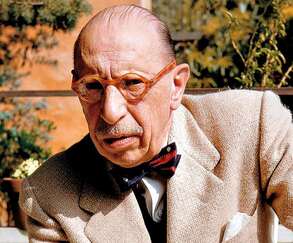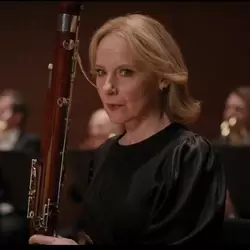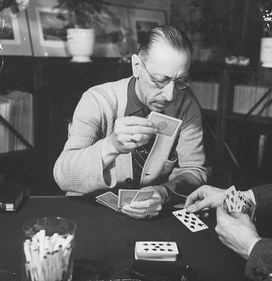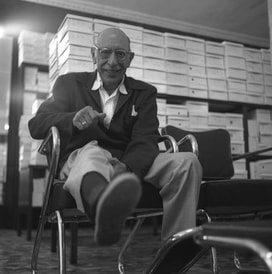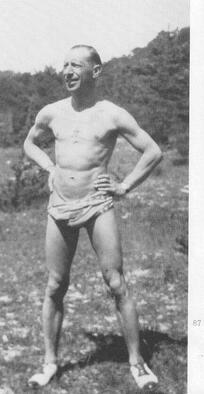Erich korngold
theme and variations, op. 42DIVE IN!
Erich Korngold (1897-1957) was an Austrian composer, pianist, and child prodigy. He began composing original music by age 7. His first ballet, at age 11, was wildly successful at its premiere in Vienna and led to further commissions for orchestra, opera, solo and chamber music. Though spending the vast majority of his career writing classical concert works, Erich Korngold is best known for his contributions to the Golden Age Hollywood film industry. Korngold left a developed and successful career in Austria in 1934 due to the rise of the Nazi regime and settled in Los Angeles at the invitation of film director Max Reinhardt to write film scores. He virtually recreated the role of music in film by treating it as opera, using Leitmotif (musical identities for major characters) and pitching the music in a range similar to the actors’ speaking voices. Korngold's influence was so great on Golden Age Hollywood film scores that it is virtually useless to try to separate his compositional style and sound into differentiated categories of "Hollywood" music or "concert" music.
RESOURCES:A recording of Theme & VariationsA great feature length documentary on Erich Korngold for supreme nerding purposes. 🤓😎❤️HIGHLIGHTS:
Theme and Variations, Op. 42 is the result of a commission from an American publisher who specialized in concert music for youth and pre-professional orchestras.
Erich Korngold composed Theme and Variations, Op. 42 in 1953, just a few years before his death. He had a superstition about this Opus number, saying "Opus forty-two. From the time I was a boy I knew I would not make it beyond opus forty-two." Indeed, it was the last piece of music he wrote before his health declined too much to allow him to continue working.
The main theme is simple and elegant, and Korngold intended for it to be performed in a folk style similar to an Irish melody.
There are seven variations on the theme, each fairly light and melodic, which utilize different instrumentations to show the colors of the orchestra from variation to variation.
Variations 1-3 are quick paced, Variation 4 is the most "Hollywood" sounding of the variations with a slower pace and dramatic stretching of the melody line. Variation 5 immediately takes up the quick pace again. Variation 6 brings the mood into a more dreamy sentimentality. Finally variation 7, the longest of the variations, closes the piece with a vibrant snappy rhythmic march with a splashy "Hollywood" style finish.
A typical performance of Theme and Variations, Op. 42 lasts about 9 minutes.Enjoy listening!Danny elfman
percussion concertoDIVE IN!
Danny Elfman (1953- ) is an American composer of concert music and film/TV scores, as well as the front musician of the band 1980s band Oingo Boingo. His compositional influences include Bernard Herrmann, Erich Korngold, Dmitri Shostakovich, and Igor Stravinsky. Elfman is best known for his film/TV scores The Simpsons, The Nightmare Before Christmas, and Batman. He is a multiple Oscar nominee and has composed around 100 film/TV scores, including nearly two dozen Tim Burton films. Elfman began writing long form composed music in 2005 and found immediate success. Colorado Symphony performed his violin concerto "Eleven Eleven" in 2019. His 2022 percussion concerto is an astonishing new addition to his concert music works, wowing audiences and ensuring his continued success.RESOURCES:Guest soloist Colin Currie comments on Danny Elfman's Percussion Concerto1st movement of Elfman's Percussion Quartet, performed by Third Coast Percussion, to get an idea of his style and approach.Song Exploder podcast episode #224 with composer Danny Elfman describing his process for creating the song "What's This" from The Nightmare Before Christmas soundtrack, in which he references Tchaikovsky, Gilbert&Sullivan, and how he ended up singing it himself.HIGHLIGHTS:
Percussion Concerto is in four movements; "Triangle", "DSCH", "Down", and "Syncopated".
"Triangle" refers to the shape being drawn between the solo percussionist at the front of the orchestra, and the two additional stations for the orchestral percussionists at the back corners of the group. This movement begins with the soloist essentially calling to the other points on the percussion triangle through driving rhythms played on non-pitched instruments before the rest of the orchestra swirls into action.
"DSCH" is an homage to composer Dmitri Shostakovich whose transliterated German musical signature "D.Sch." translates to a tune built on the tones D, E-flat, C, B. Shostakovich used this musical signature frequently in his works. Elfman threads it throughout this movement, creating different moods with it - sometimes playful, sometimes somber, always interesting. We hear the DSCH tune being built up right away at the beginning in the solo vibraphone.
"Down" is about the feeling of being low but although it starts with a very sparse texture in the strings, it includes some quicker paced music sounding vaguely like a creepy waltz trying to find its swing. This movement is moody and somewhat cloudy sounding, starting with a long orchestral introduction. The solo percussionist spends more time on metalic instruments in this movement, adding to a colder characteristic. Additionally, toward the end of the movement, Elfman uses more intimate sounding instruments for the soloist; talking drum, and waterphone - a metal vessel partially filled with water whose external spikes are bowed creating an evocative creaking sound.
"Syncopated" is a tour de force finale for the soloist and the orchestra, filled with jabbing dancing off beat rhythms that drive us all the way to the end.
A typical performance of Percussion Concerto lasts about 30 minutes.
Danny Elfman's own words:
Percussion has always been an important part of my life. Beginning in my travels though West Africa when I was only 18 years old, when I began collecting and learning to play ‘balafons’ (kind of like the African version of a marimba), through my years of playing in metal-based Indonesian Gamalan ensembles in my twenties, as well as building my own strange metal and wood percussion ensembles in my early theatrical performance years, it has always been a lifelong obsession.
Shortly after we premiered my first violin concerto, which I composed for violinist Sandy Cameron, I had a chance meeting with percussionist Colin Currie during a film scoring session in London. We decided it could be fun to create a piece together. I was excited to take another plunge into the challenge of another large symphonic composition and at the same time to really go back to my roots with wood and metal, mallets and sticks and hands, and to really let loose and have some fun with it. I also knew Colin was an extraordinary musician who would be great to collaborate with.NERD ASSIGNMENTS!
Start with a Conversation:
A concerto is a type of musical form that creates dialogue and drama between a single performer, and a much larger group of performers. What exactly is dialogue? How is dialogue made? Think about constructing a brief dialogue between two people. What can you do to alter this dialogue so that one participant becomes a whole group of people? What are some examples of this type of dialogue you can think of in your every day life? [call and response in pep rallies, a religious service, etc.] Now imagine what it might be like if each person in the large group had an individual response in this dialogue. Would we be able to understand all the responses simultaneously? In music, many different sounds (often called ‘voices’) can be processed simultaneously by the human ear. Because of this it’s possible to have a two part musical dialogue with many individual voices!
Listening for dialogue and interpretation
Try to listen carefully for musical dialogue and dramatic interpretive elements in this composition. How did the conversation and comparison/contrast activities help you to better engage as a listener?igor stravinsky
the firebird Suite (1945 version)DIVE IN!
Russian composer Igor Stravinsky (1882-1971) is one of the most highly revered composers of the 1900s. The Firebird, composed in 1910, was the first in a series of three ballets composed for Sergei Dhiagalev's Ballet Russes. Along with the other two, Petrushka and The Rite of Spring, this trio of large scale ballet compositions are among Stravinsky's most celebrated works.RESOURCES:A live 1959 performance recording with Stravinsky himself conducting!As heard in Disney's Fantasia 2000!
HIGHLIGHTS:
Igor Stravinsky was still fairly unknown as a composer when he was asked to write the music that would become The Firebird ballet. In fact, he was the third choice after the first two composers turned down the opportunity.
The ballet's original inspiration came from lines of a poem by Yakov Polonsky "A Winter's Journey":
And in my dreams I see myself on a wolf's back
Riding along a forest path
To do battle with a sorcerer-tsar
In that land where a princess sits under lock and key,
Pining behind massive walls.
There gardens surround a palace all of glass;
There Firebirds sing by night
And peck at golden fruit.
Stravinsky finished composing the music for The Firebird in just six months. Sneak peak reviews were strong, including one from French critic Robert Brussel "By the end of the first scene, I was conquered: by the last, I was lost in admiration. The manuscript on the music-rest, scored over with fine pencillings, revealed a masterpiece."
The Firebird was an immediate hit and went on to great acclaim worldwide. New York City Ballet's 1949 staging of The Firebird resulted in its first major success just one year after the founding of the company, It was choreographed by George Ballanchine, with scenery and costumes by Marc Chagall, and with Maria Tallchief dancing the Firebird role.
The Firebird is a dramatic sounding work, which to our 21st century ears sounds cinematic. Stravinsky used composition techniques common in opera and ballet contexts to draw attention to characters, emotions, place and action. He also asks the orchestra musicians to use special techniques to achieve uncommon evocative "creepy" sounds from time to time.
The cinematic qualities of The Firebird, in addition to its lasting popularity, were likely the primary reasons for its inclusion in Disney's reboot of the Fantasia film in 2000. The companion ballet, The Rite of Spring, had been used in the original Fantasia as well.
The Firebird was so popular Stravinsky made several concert suite versions including the 1919 version, which is the most often performed, and the 1945 version which includes more material from the ballet.
For you Only Murders In The Building fans, you'll recognize the Berceuse solo that Jan, the Steve Martin character's villainous murdering bassoonist girlfriend, obsessed about in episode 9 of season 1.
A typical performance of the 1945 version lasts about 30 minutes.Jan's comin' for ya... LOOK OUT!EXTRAS:
As is my way, the fun stuff!
First a few photos of Stravinsky being a regular person to show him as... well... a regular person!
Last, I will never not share the lockdown boredom creative brilliance of percussionist Rocco Luigi Bitondo's gnome series. Enjoy the final dance of The Rite of Spring as performed by the VERY EXTREMELY IMPORTANT bass drum and timpani. They are the real conductors the orchestra relies upon in case of disaster in this section of this piece. If only Bitondo had made a Firegnome performance of The Firebird...
READY TO ENGAGE!
Please share your experience with me – [email protected]!
I’d love to hear about it or see any of your activities, journaling, or creations!
I’d love to hear about it or see any of your activities, journaling, or creations!




